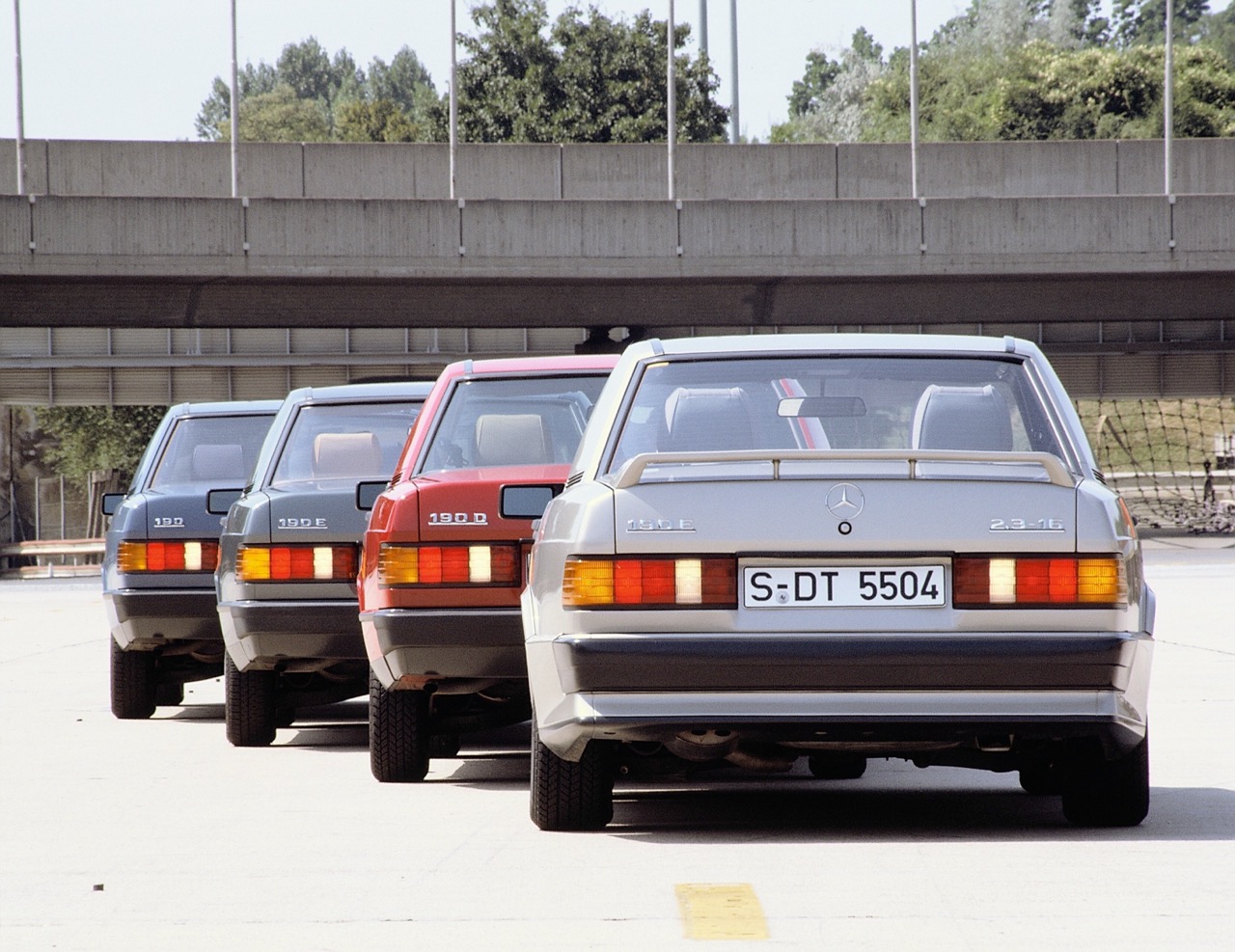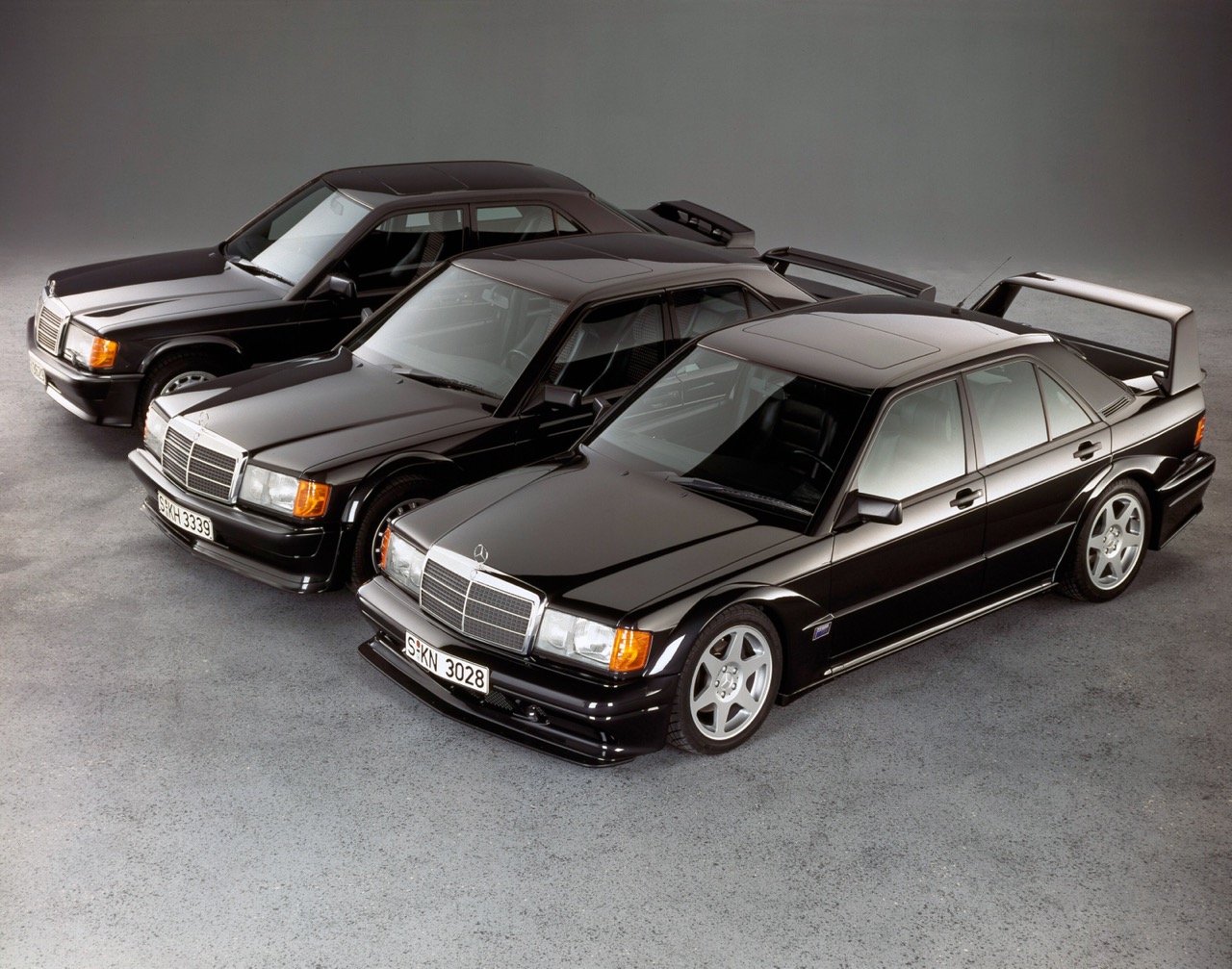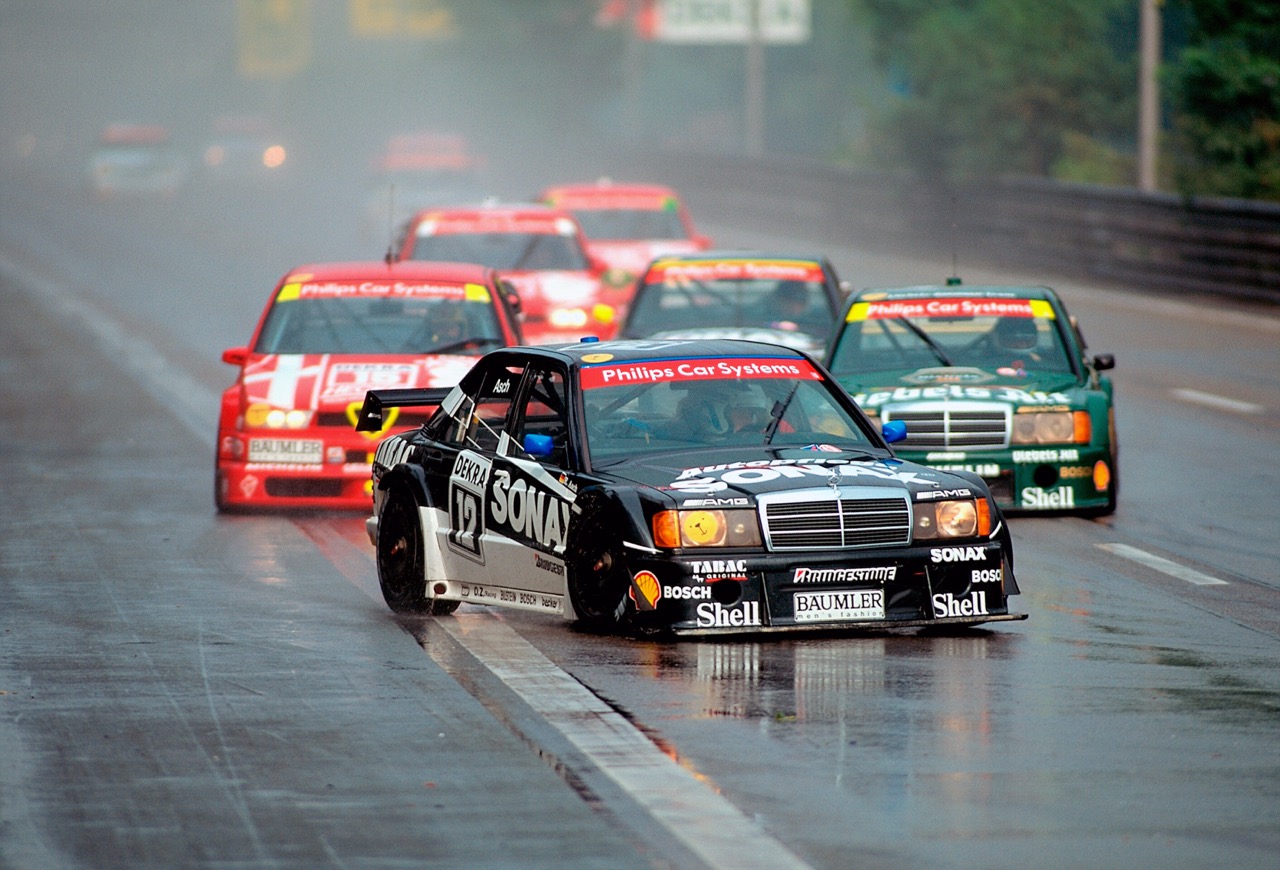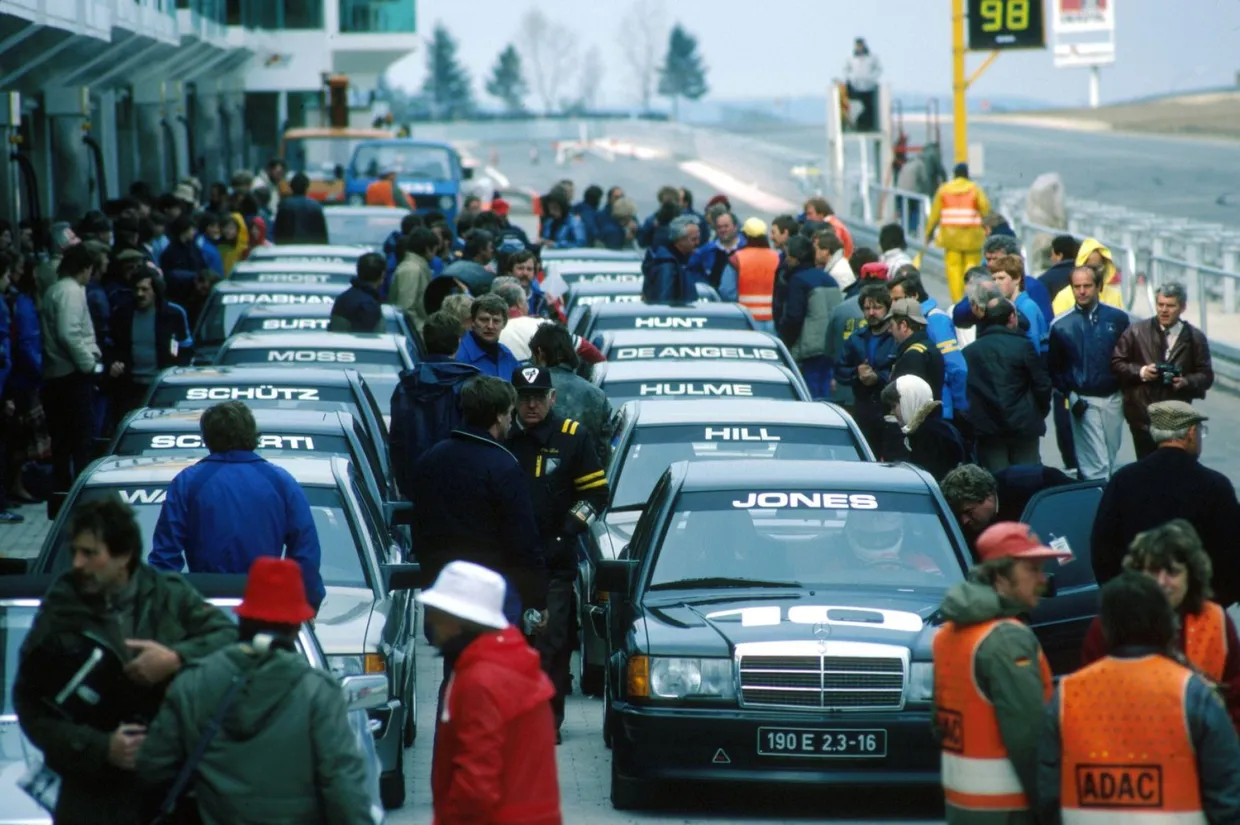The Mercedes-Benz 190E
Today the majority of sales for Mercedes-Benz are from their smaller models, however, this was not always the case. Mercedes-Benz was a manufacturer traditionally targeting luxury, think of the current market positioning of Bentley, only offering high-end models.
By doing this, however, Mercedes was missing out on a huge, and growing, market segment: the premium compact saloon. Consumers who wanted something more upmarket than a Ford or a Vauxhall would turn to BMW or Audi; however Mercedes wanted to drive a wedge into that, a Bruno Sacco-designed box-shaped wedge.
Hence a car was designed to fit the compact segment whilst still keeping the USP of a Mercedes: luxury and reliability. Its competitors, the BMW E30, offered dynamic prowess, and the Audi 80 offered technological innovation in the form of Quattro.
 Photography courtesy of Mercedes-Benz
Photography courtesy of Mercedes-Benz
Mercedes offered the 190E in various engine configurations for efficiency and power but for the first time in a long time, Mercedes had a lightweight platform with racing potential.
Below are the specifications for the top-of-the-line Evolution II model.
| Production: | 1990–1991, 502 units built for homologation |
| Engine: | Front, longitudinal inline-4, 2,463 cc, DOHC, 4 valves/cylinder, Cosworth-developed |
| Power & Torque: | 235 hp @ 7,200 rpm; 245 Nm @ 5,000 rpm |
| Transmission: | 5-speed Getrag dogleg manual, rear-wheel drive |
| Chassis & Body: | Steel monocoque with wind-tunnel-developed aero kit (wing, flared arches, splitter) |
| Suspension (F/R): | Independent; MacPherson struts (F), multi-link (R), adjustable ride height |
| Brakes & Steering: | Ventilated disc brakes (F/R); power-assisted recirculating ball steering |
| Dimensions (L × W × H): | 4,446 × 1,714 × 1,368 mm |
| Wheelbase: | 2,670 mm (105.1 in) |
| Weight: | 1,340 kg (2,954 lbs) |
| Top Speed: | 250 km/h (155 mph) electronically limited |
| Fuel Tank: | 55 liters (14.5 US gallons) |
| Tires (F/R): | 225/45 ZR17 (Front); 245/40 ZR17 (Rear) |
DTM
1984 was the birth year of the most famous German racing series, the Deutsche Produktionswagen Meisterschaft, or more succinctly, DTM.
The concept of DTM was refreshingly grounded: take production saloon cars, add a dash of motorsport seasoning, and send them out to duel on Germany’s most storied circuits. No prototype class, just recognisable cars driven to their limits.
In 1986, with minor modifications to their 2.3 Cosworth road car, Mercedes entered the 190E into DTM. Throughout the 1986 season, although competitive, the 190E struggled to match the agility and pace of its main rival, the BMW E30 M3. The M3 was lighter, more nimble, and had been engineered with motorsport in mind from the outset.
 Photography courtesy of Mercedes-Benz
Photography courtesy of Mercedes-Benz
Undeterred, Mercedes pressed on. In 1988 they introduced the 2.5-16 Evolution I. A homologation special with revised aerodynamics, improved suspension geometry, and a bored out engine. It narrowed the gap to the E30, but the real turning point was with the subsequent Evolution II, which was released in 1990.
The Evolution II had a wind-tunnel-honed silhouette that looked every bit as serious as it performed; with Klaus Ludwig behind the wheel, the 190E was not just keeping up but instead setting the pace. In 1992, it secured both the DTM drivers’ title and the Constructors’ Championship – a landmark moment for Mercedes-Benz.
 Photography courtesy of Mercedes-Benz
Photography courtesy of Mercedes-Benz
This was a turning point for Mercedes-Benz, once a buttoned-up luxury brand had proven that their cars could compete dynamically with the likes of BMW and Audi.
Rallying
While the 190E is celebrated for its DTM exploits, Mercedes originally envisioned the 190E as a rally contender. In the late 1970s they commissioned Cosworth to develop the high-performance engine specifically for rallying. However, with the emergence of Audi’s Quattro and its all-wheel-drive system, the rallying landscape quickly changed. Mercedes realised that their rear-wheel-drive 190E would be at a disadvantage so they shifted focus to touring car racing instead.
Despite the absence of a factory-backed rally program, the 190E found its way onto rally stages through privateers. Notably in 1987, French rally driver Bernard Darniche piloted a 2.3-16 190E in the famous Rallye Monte Carlo. And a few years later, José Luis Rivero achieved a commendable fourth-place finish in the 1988 Rally Costa de Almeria.
While the 190E’s rallying chapter was brief, it remains a testament to the car’s engineering prowess and demonstrates the versatility of the small-saloon platform.
The 1984 Race of Champions
Motorsport fans have often dreamed of putting racing drivers into the same car and seeing who would win with a level field. This is what Mercedes somehow managed to arrange in 1984.
 Photography courtesy of Mercedes-Benz
Photography courtesy of Mercedes-Benz
The race took place at the infamous Nürburgring, being staged to celebrate the newly rebuilt Nürburgring Grand Prix circuit. Rather than invite journalists they gathered 20 of the world’s top Formula One drivers–past and present–for an outright battle in 2.3-16 190Es. This was pre-DTM, so the 190E had not yet earned its reputation on track, so this race was meant to showcase its dynamic capabilities under the most intense scrutiny imaginable.
Name a legendary Formula One driver from the golden age–Senna, Lauda, Hunt, Prost, Brabham–they were all there. The only differentiator between the cars being the respective moniker on the sunstrip.
Senna, was at the time racing in Formula Three, and had not yet graduated to Formula One. However despite being the youngest and least experienced, Ayrton Senna stunned everyone by winning the race in dominant fashion. He qualified on pole and led from the front, showcasing the sublime car control and aggression that would become his trademark. Second place was Niki Lauda and third came Carlos Reutemann both with exceptional drives. The event proved that Mercedes’ little saloon could compete dynamically with the best.
Conclusion
Manufacturers are often known for creating a ‘halo’ car, something that doesn’t sell enough to make a profit but works as a marketing exercise to elevate the brand. The halo car usually sits at the top of the range, think the R8, Carrera GT or LFA. Unusually, the 190E became a halo car for Mercedes at the entry level, earning them several motorsport wins whilst being the most attainable car in their range. A blue-collar hero? Maybe not–it’s still a Mercedes after all.
| Photography: | Provided by Mercedes-Benz for reporting purposes. |
| Ethics: | No brand affiliation and not a sponsored article. Opinions are our own. |